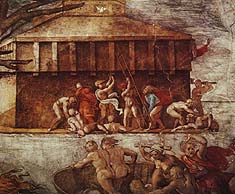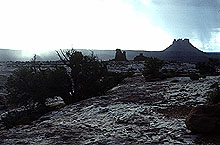Rain: A physical event with diverse cultural meanings
The way cultural meaning governs a group's understanding of its physical environment can be illustrated with the example of how physical event of rain is interpreted in two different cultural traditions.
 In the Judeo-Christian cultural tradition, rain served as tool of God's wrath. Angered by the behavior of his people, God sent forty days and forty nights of rain; the only survivors were the favored family of Noah and the pairs of animals which found refuge on the ark. While in other biblical narratives rain functions as a blessing, this Old Testament story has been very influential in establishing the place of rain and storm imagery in the cultural meaning system. One result of this system of meaning is that rain images like thunder, lightning, wind, and flood tend to symbolize ominous things like anger, danger, and hardship in cultures which descend from the Judeo-Christian tradition. Examples of this effect can be found throughout Western legends and literatures. Take, for instance, the Anglo Saxon poem "The Wanderer," one of the oldest remaining poems in the English language, in which the author warns of a time "when all the wealth of the world will be in waste, as even now here and there throughout the world walls stand blown by the wind, covered by frost, the dwellings beaten by storms" (l. 75-77; our emphasis). From "The Wanderer" to Shakespeare's The Tempest to a variety of modern literatures, the association of rain with danger and calamity has been a consistent theme of the West European and Euro-American storyteller's imagination. Hence, when weather forecasters predict rain, they do so apologetically; when we are in the "eye of the storm," we are surrounded by danger; when we are in "the calm before the storm," something ominous and bad is about to happen. The physical event of the rainstorm, as perceived through this particular cultural lens, tends to mean or symbolize something negative.
In the Judeo-Christian cultural tradition, rain served as tool of God's wrath. Angered by the behavior of his people, God sent forty days and forty nights of rain; the only survivors were the favored family of Noah and the pairs of animals which found refuge on the ark. While in other biblical narratives rain functions as a blessing, this Old Testament story has been very influential in establishing the place of rain and storm imagery in the cultural meaning system. One result of this system of meaning is that rain images like thunder, lightning, wind, and flood tend to symbolize ominous things like anger, danger, and hardship in cultures which descend from the Judeo-Christian tradition. Examples of this effect can be found throughout Western legends and literatures. Take, for instance, the Anglo Saxon poem "The Wanderer," one of the oldest remaining poems in the English language, in which the author warns of a time "when all the wealth of the world will be in waste, as even now here and there throughout the world walls stand blown by the wind, covered by frost, the dwellings beaten by storms" (l. 75-77; our emphasis). From "The Wanderer" to Shakespeare's The Tempest to a variety of modern literatures, the association of rain with danger and calamity has been a consistent theme of the West European and Euro-American storyteller's imagination. Hence, when weather forecasters predict rain, they do so apologetically; when we are in the "eye of the storm," we are surrounded by danger; when we are in "the calm before the storm," something ominous and bad is about to happen. The physical event of the rainstorm, as perceived through this particular cultural lens, tends to mean or symbolize something negative.
 Such is not the case in all cultures. In the Anasazi culture, for example, rain was held to be sacred. The Anasazi lived in the Four Corners region of the desert southwest -- an arid high-desert environment. Reliant upon the winter snow in the mountain to feed streams and springs throughout the year, and reliant on spring rainshowers to supplement their strenuous irrigation efforts, the Anasazi culture came to view rain as a gift from the Rain God. During winter storms, Anasazi spiritual leaders thanked the Rain God for the water which they knew would accumulate in the mountain snowpack. In the spring and summer, they prayed and conducted ceremonies to honor the Rain God in hopes of gaining favor and the precious gift of water. As a result of this system of meaning in which rainfall symbolized the benevolence and generosity of the natural world, Anasazi legends and the literature of the cultures which grew out of Anasazi tradition tend to represent rain in a positive way. One striking example of this is the ancient Anasazi rock art, consisting of pictographs (paintings) and petroglyphs (engravings) left on boulders or canyon walls, in which the Rain God is depicted with arms outstretched and sheets of rain falling from the arms (see photo, above). Further examples can be found in the prayers of modern descendants of the Anasazi. The Zuni have a prayer that goes as follows:
Such is not the case in all cultures. In the Anasazi culture, for example, rain was held to be sacred. The Anasazi lived in the Four Corners region of the desert southwest -- an arid high-desert environment. Reliant upon the winter snow in the mountain to feed streams and springs throughout the year, and reliant on spring rainshowers to supplement their strenuous irrigation efforts, the Anasazi culture came to view rain as a gift from the Rain God. During winter storms, Anasazi spiritual leaders thanked the Rain God for the water which they knew would accumulate in the mountain snowpack. In the spring and summer, they prayed and conducted ceremonies to honor the Rain God in hopes of gaining favor and the precious gift of water. As a result of this system of meaning in which rainfall symbolized the benevolence and generosity of the natural world, Anasazi legends and the literature of the cultures which grew out of Anasazi tradition tend to represent rain in a positive way. One striking example of this is the ancient Anasazi rock art, consisting of pictographs (paintings) and petroglyphs (engravings) left on boulders or canyon walls, in which the Rain God is depicted with arms outstretched and sheets of rain falling from the arms (see photo, above). Further examples can be found in the prayers of modern descendants of the Anasazi. The Zuni have a prayer that goes as follows:
Cover my earth mother four times with many flowers.
Let the heavens be covered with the banked-up clouds.
Let the earth be covered with fog; cover the earth with rains.
Great waters, rains, cover the earth. Lightning cover the earth.
Let thunder be heard over the earth; let thunder be heard,
Let thunder be heard over the six regions of the earth.
(Roberts and Amidon 149)
This prayer is "traditional," meaning that it has been handed down for generations and may be of ancient origin. Even today, however, traditional systems of meaning like those of the Anasazi continue to exert influence over Native Americans, not only in their prayers and literature but in their behavior and attitudes toward the earth. These systems of meaning operate as a filter, giving significance and meaning to group members' perceptions of the physical world around them.
go back to the top of this page
 go back to the Environment Gallery
go back to the Environment Gallery
 go back to What Is Culture? page
go back to What Is Culture? page
 In the Judeo-Christian cultural tradition, rain served as tool of God's wrath. Angered by the behavior of his people, God sent forty days and forty nights of rain; the only survivors were the favored family of Noah and the pairs of animals which found refuge on the ark. While in other biblical narratives rain functions as a blessing, this Old Testament story has been very influential in establishing the place of rain and storm imagery in the cultural meaning system. One result of this system of meaning is that rain images like thunder, lightning, wind, and flood tend to symbolize ominous things like anger, danger, and hardship in cultures which descend from the Judeo-Christian tradition. Examples of this effect can be found throughout Western legends and literatures. Take, for instance, the Anglo Saxon poem "The Wanderer," one of the oldest remaining poems in the English language, in which the author warns of a time "when all the wealth of the world will be in waste, as even now here and there throughout the world walls stand blown by the wind, covered by frost, the dwellings beaten by storms" (l. 75-77; our emphasis). From "The Wanderer" to Shakespeare's The Tempest to a variety of modern literatures, the association of rain with danger and calamity has been a consistent theme of the West European and Euro-American storyteller's imagination. Hence, when weather forecasters predict rain, they do so apologetically; when we are in the "eye of the storm," we are surrounded by danger; when we are in "the calm before the storm," something ominous and bad is about to happen. The physical event of the rainstorm, as perceived through this particular cultural lens, tends to mean or symbolize something negative.
In the Judeo-Christian cultural tradition, rain served as tool of God's wrath. Angered by the behavior of his people, God sent forty days and forty nights of rain; the only survivors were the favored family of Noah and the pairs of animals which found refuge on the ark. While in other biblical narratives rain functions as a blessing, this Old Testament story has been very influential in establishing the place of rain and storm imagery in the cultural meaning system. One result of this system of meaning is that rain images like thunder, lightning, wind, and flood tend to symbolize ominous things like anger, danger, and hardship in cultures which descend from the Judeo-Christian tradition. Examples of this effect can be found throughout Western legends and literatures. Take, for instance, the Anglo Saxon poem "The Wanderer," one of the oldest remaining poems in the English language, in which the author warns of a time "when all the wealth of the world will be in waste, as even now here and there throughout the world walls stand blown by the wind, covered by frost, the dwellings beaten by storms" (l. 75-77; our emphasis). From "The Wanderer" to Shakespeare's The Tempest to a variety of modern literatures, the association of rain with danger and calamity has been a consistent theme of the West European and Euro-American storyteller's imagination. Hence, when weather forecasters predict rain, they do so apologetically; when we are in the "eye of the storm," we are surrounded by danger; when we are in "the calm before the storm," something ominous and bad is about to happen. The physical event of the rainstorm, as perceived through this particular cultural lens, tends to mean or symbolize something negative.

 go back to the Environment Gallery
go back to the Environment Gallery go back to What Is Culture? page
go back to What Is Culture? page